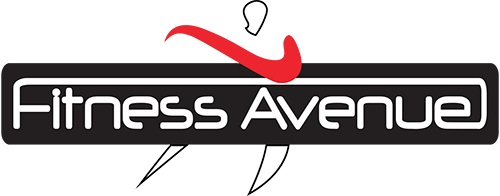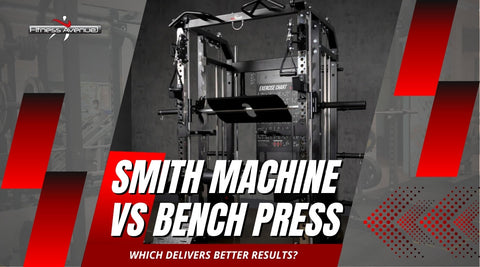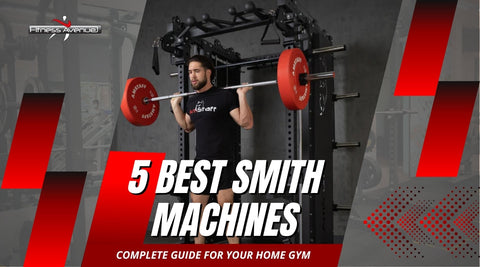Vous hésitez entre investir dans une machine Smith ou un banc de musculation traditionnel pour votre salle de sport à domicile ? Vous n'êtes pas seul. Chez Fitness Avenue , nous accompagnons régulièrement les passionnés de fitness dans cette décision importante qui peut avoir un impact significatif sur leurs résultats en musculation.
Le débat entre l'entraînement sur Smith machine et l'entraînement au développé couché fait l'objet de fervents défenseurs des deux camps. Si certains ne jurent que par la stabilité et la sécurité de la Smith machine, d'autres vantent les avantages du développé couché avec poids libres en termes de force fonctionnelle. Alors, lequel est vraiment le plus adapté à vos objectifs fitness ?
Dans ce guide complet, nous analyserons les principales différences entre les machines Smith et les développé couchés, analyserons leur impact sur le développement musculaire et vous aiderons à déterminer quelle option correspond le mieux à vos objectifs de remise en forme, à votre niveau d'expérience et à vos préférences d'entraînement.
Tableau comparatif complet des appareils Smith Machine et Bench Press
|
Fonctionnalité |
Smith Machine |
Développé couché |
|---|---|---|
|
Modèle de mouvement |
Chemin fixe vertical ou incliné |
Chemin de déplacement libre et naturel |
|
Activation musculaire |
Muscles primaires avec moins d'activation des stabilisateurs |
Muscles primaires plus activation significative des stabilisateurs |
|
Convient aux débutants |
Modèle de mouvement hautement guidé |
Modéré - nécessite la maîtrise de la technique |
|
Sécurité lors du levage d'une charge solo |
Haut - crans de sécurité intégrés |
Bas - observateur recommandé |
|
Capacité de poids |
Peut souvent supporter plus de poids en raison de sa stabilité |
Généralement limité par la force des muscles stabilisateurs |
|
Développement de la force fonctionnelle |
Modéré - limité par un chemin fixe |
Élevé - transferts vers des mouvements du monde réel |
|
Versatilité |
Exercices multiples avec pièces jointes |
Nécessite un équipement séparé pour les variations |
|
Besoins en espace |
Système autonome |
Nécessite un banc, un support et un espace pour la barre |
Différences clés entre le développé couché et la Smith Machine
La différence fondamentale entre une Smith Machine et un développé couché traditionnel réside dans la trajectoire de la barre et la liberté de mouvement. Avec une Smith Machine comme notre Smith Machine tout-en-un AmStaff Fitness SD-3000 , la barre est fixée à un système de rails, ce qui lui permet de se déplacer uniquement selon une trajectoire verticale ou légèrement inclinée prédéterminée.
En revanche, un développé couché avec poids libres, composé d'un banc de qualité et d'une barre olympique, permet une liberté de mouvement illimitée dans tous les plans. Cette liberté implique que votre corps contrôle non seulement le poids lui-même, mais aussi la trajectoire et la stabilisation de la barre.
Brandon, entraîneur personnel et client de Fitness Avenue, explique : « Le développé couché sur machine Smith crée un environnement prévisible pour l'entraînement des pectoraux, ce qui permet aux débutants de se concentrer sur le mouvement de la presse sans se soucier de la stabilisation de la barre. Le développé couché avec poids libres développe une force plus complète du haut du corps, mais la courbe d'apprentissage est plus raide. »
Types d'exercices

Les machines Smith et les configurations de développé couché permettent tous deux de réaliser divers exercices pour la poitrine, les épaules et les triceps, mais ils offrent des avantages différents.
Options d'exercices avec la Smith Machine :
- Développé couché traditionnel (plat, incliné, décliné)
- Développé couché prise serrée pour les triceps
- Presse militaire pour les épaules
- Squats et fentes bulgares
- rangées inversées
- Élévations des mollets
Options de développé couché avec poids libres :
- Variations du développé couché avec haltères
- Presse à plancher
- Presse à bord
- Pause des répétitions
- Résistance de la chaîne/bande
Les machines Smith, comme notre AmStaff Fitness SD-2500 tout-en-un, offrent une polyvalence impressionnante grâce à leurs systèmes de câbles intégrés offrant des options d'exercices supplémentaires. Cependant, les configurations avec poids libres et haltères olympiques de qualité permettent des variations plus subtiles de la largeur de prise, de la trajectoire de la barre et du positionnement des pieds.
Chemin et forme de la barre
Le parcours guidé de la Smith Machine présente à la fois des avantages et des limites. S'il offre un schéma de mouvement cohérent qui peut réduire les risques de blessure pour les débutants, il force également votre corps à suivre un parcours prédéterminé qui peut ne pas correspondre à votre mécanique de pression naturelle.
Des recherches ont montré que lors d'un développé couché classique, la trajectoire naturelle de la barre n'est pas parfaitement verticale. Elle suit plutôt une légère courbe en « J », remontant et remontant vers les épaules. La trajectoire fixe de la Smith Machine ne permet pas ce mouvement naturel, ce qui peut exercer une pression anormale sur les articulations, notamment les épaules et les poignets.
Mike, coach sportif chez Fitness Avenue, explique : « J’utilise les deux avec mes clients, mais à des fins différentes. La machine Smith aide les débutants à apprendre les mouvements de pression avec moins de risques, tandis que le développé couché avec poids libres développe des mouvements plus naturels, essentiels à une progression durable. »
Développer la force fonctionnelle
Pour développer une force concrète transférable aux activités quotidiennes et aux performances sportives, le développé couché avec poids libres offre généralement de meilleurs résultats. Le recrutement des muscles stabilisateurs et la coordination requise pour contrôler une barre libre reflètent plus fidèlement les exigences des activités quotidiennes.
L'entraînement sur Smith Machine isole les muscles moteurs principaux (muscles pectoraux, épaules, triceps) sans nécessiter de stabilisation significative des groupes musculaires secondaires. Cette isolation musculaire ciblée peut être bénéfique en musculation, mais peut ne pas être aussi efficace pour les mouvements fonctionnels en dehors de la salle de sport.
Une étude comparant la machine Smith au développé couché avec poids libres a révélé que l'entraînement avec poids libres produit généralement des gains de force plus importants, transférables à diverses tâches, tandis que l'entraînement avec la machine Smith excelle dans le développement de la masse et de la force, en particulier des principaux muscles ciblés. Voici pourquoi choisir une machine Smith .
Activation musculaire et hypertrophie
Contrairement à ce que certains pensent, les recherches montrent que les machines Smith et le développé couché avec poids libres permettent de développer efficacement les muscles lorsque l'intensité et le volume d'entraînement sont adaptés. Cependant, le schéma d'activation musculaire diffère considérablement entre les deux.
Des études EMG ont révélé une activation similaire des principaux muscles pectoraux (grand pectoral) entre la machine Smith et le développé couché avec poids libres. Cependant, le développé couché avec poids libres sollicite davantage les muscles stabilisateurs, notamment au niveau des épaules, du haut du dos et du tronc.
Cette différence d'activation musculaire ne signifie pas nécessairement qu'un individu est supérieur pour développer sa masse musculaire ; cela signifie simplement que les deux types de muscles développent leur force selon des schémas différents. Pour un développement complet, de nombreux haltérophiles sérieux intègrent les deux modalités à leur programme d'entraînement.
Considérations de sécurité

La sécurité est un facteur crucial lors du choix entre une machine Smith et un développé couché à poids libre, en particulier pour les utilisateurs de salle de sport à domicile qui s'entraînent souvent seuls.
Les machines Smith sont équipées de mécanismes de sécurité intégrés. Le chemin de barre fixe et les butées de sécurité réglables vous permettent de vous entraîner en toute confiance, même sans accompagnateur. Notre machine Smith tout-en-un AmStaff Fitness SD-4000 est dotée de crans de sécurité facilement réglables qui vous protègent si vous ne parvenez pas à terminer une répétition.
Le développé couché avec poids libres exige généralement plus de prudence lorsqu'on s'entraîne seul. Sans accompagnateur, des techniques comme le « rouleau de la honte » (faire rouler la barre le long du corps en cas d'échec) deviennent des protocoles de sécurité indispensables. L'utilisation d'un rack de musculation avec des goupilles de sécurité correctement réglées peut offrir une protection similaire aux butées de sécurité d'une Smith Machine.
Shannon, propriétaire d'une salle de sport à domicile, partage : « Comme je m'entraîne seule, ma machine Smith me donne confiance pour soulever des poids plus lourds en toute sécurité. Lorsque mon partenaire d'entraînement est disponible, nous intégrons davantage de travail avec des poids libres. »
Avantages des poids libres
Le développé couché avec poids libres offre plusieurs avantages distincts :
- Modèles de mouvements naturels : permettent à votre corps de se déplacer selon son chemin le plus efficace et le plus naturel.
- Développement des muscles stabilisateurs plus importants : engage davantage de groupes musculaires, en particulier ceux responsables de la stabilisation des articulations.
- Proprioception améliorée : améliore la conscience de votre corps de la position et du mouvement dans l'espace.
- Développement progressif des compétences : Enseigne une forme appropriée qui se transfère à d’autres exercices et activités.
- Transfert de performance athlétique : les recherches suggèrent que l’entraînement avec poids libres a un meilleur transfert vers les sports et les activités quotidiennes.
Chez Fitness Avenue, notre sélection de bancs haut de gamme, d'haltères de qualité et des meilleures machines Smith du marché fournit tout ce dont vous avez besoin pour une configuration d'entraînement aux poids libres efficace.
Avantages et inconvénients de l'utilisation d'une Smith Machine pour le développé couché
Avantages :
- Sécurité renforcée pour l'entraînement en solo
- Confiance pour soulever des poids plus lourds
- Modèle de mouvement cohérent
- Courbe d'apprentissage plus facile pour les débutants
- Station tout-en-un avec plusieurs options d'exercices
- Temps d'installation réduit
Inconvénients :
- Le chemin de mouvement fixe peut ne pas correspondre aux mécanismes naturels
- Activation des muscles moins stabilisateurs
- Potentiel de développement de déséquilibres
- Peut ne pas être aussi bien transféré à la force du monde réel
- Généralement plus cher qu'une configuration de base avec banc plat et barre
- Nécessite plus d'espace au sol
Notre machine Smith pliable Altas AL-3101 répond au problème d'espace grâce à sa conception pliable, ce qui la rend idéale pour les utilisateurs de salle de sport à domicile disposant d'un espace limité.
FAQ
La machine Smith est-elle meilleure pour le développé couché ?
Le développé couché Smith Machine n'est ni meilleur ni pire en soi ; il est simplement différent. Il est idéal pour les débutants qui apprennent le mouvement, ceux qui s'entraînent seuls sans accompagnateur et les haltérophiles qui se concentrent sur le développement musculaire spécifique. Le développé couché avec poids libres est supérieur pour développer la force globale, améliorer la coordination et optimiser les performances sportives.
Peut-on développer sa poitrine avec une machine Smith ?
Absolument ! Les recherches montrent une activation similaire des muscles pectoraux (poitrine) lors des exercices sur Smith machine et sur développé couché avec poids libres. Bien que les exigences de stabilisation diffèrent, le principal stimulus musculaire pour la poitrine est comparable, surtout avec un entraînement d'intensité et de volume appropriés.
Une barre de machine Smith pèse-t-elle 45 lb ?
Contrairement aux barres olympiques standard qui pèsent 20 kg (45 lb), les barres Smith Machine pèsent généralement entre 7 et 13 kg selon le modèle. De nombreuses Smith Machines intègrent également un système de contrepoids qui réduit encore le poids effectif de la barre. Il est important de garder cela à l'esprit lorsque vous suivez vos progrès en musculation ou lorsque vous comparez les exercices Smith Machine à ceux à poids libres.
Peut-on développer ses muscles avec une machine Smith ?
Oui, les machines Smith sont très efficaces pour développer la masse musculaire. En offrant stabilité et sécurité, elles permettent de se concentrer sur les muscles ciblés, réduisant ainsi le risque de perte de posture. Bien qu'elles sollicitent moins les muscles stabilisateurs que les poids libres, le principal stimulus pour la croissance musculaire – la surcharge progressive – est facilement réalisable avec une machine Smith.
En résumé
Les machines Smith et le développé couché avec poids libres ont tous deux gagné leur place dans les programmes de musculation efficaces. Plutôt que de les considérer comme des concurrents, considérez-les comme des outils complémentaires qui répondent à des objectifs différents dans votre parcours de remise en forme.
Pour les débutants, les personnes s'entraînant seules ou les haltérophiles se concentrant sur le développement musculaire isolé, une machine Smith offre un excellent équilibre entre sécurité et efficacité. Notre gamme de machines Smith offre des options adaptées à tous les besoins en termes d'espace et de budget.
Pour ceux qui privilégient la force fonctionnelle, la performance athlétique ou l'haltérophilie de compétition, investir dans un banc et une barre de qualité reste la référence. La sélection premium de bancs réglables et de barres olympiques de Fitness Avenue offre tout le nécessaire pour un entraînement efficace avec poids libres.
De nombreux haltérophiles expérimentés intègrent les deux modalités dans leur entraînement : ils utilisent des poids libres pour les mouvements de base tout en utilisant la machine Smith pour le travail accessoire, l'entraînement à volume élevé ou lorsqu'ils s'entraînent sans observateur.
Que vous optiez pour une machine Smith, un système de musculation à poids libres ou une combinaison des deux, Fitness Avenue possède l'équipement et l'expertise nécessaires pour vous aider à créer l'environnement de musculation idéal. Visitez-nous en ligne ou dans nos locaux de Toronto, Barrie, Longueuil ou London pour découvrir notre gamme complète d'équipements de musculation.



